Auburn University researcher part of team identifying fast-multiplying New York City ant
An unidentified ant that went viral following its discovery in the heart of New York City has finally been studied and identified.
The ant first made national headlines and was dubbed the ManhattAnt in 2011. New York City has been the site of introduction for some of North America’s most damaging invasive pests, but there was little follow up on the ManhattAnt since its discovery.
A team of researchers led by Clint Penick from Auburn University used genetic and morphological approaches to confirm the identity of the ManhattAnt and characterize its introduced range and colony structure, which was published this week in Biological Invasions.
“After we discovered a new ant living in the heart of New York City, we realized it’s quickly becoming one of the most common ants in Manhattan,” Penick said. “In our new article, we finally identify it as an introduced ant from Europe, and we track its spread into New Jersey and surrounding region.”
Results from genetic analyses placed the ManhattAnt within the genus Lasius, and morphological comparisons ruled out closely related species to finally identify it as the European ant Lasius emarginatus with 93-99% certainty depending on the nest sample.
Since its initial discovery in the region, the ManhattAnt has become one of the most common ants in New York City and has spread at a rate of 2 kilometers per year into New Jersey and onto Long Island.
Based on the climate it inhabits within its native range, the ManhattAnt could expand to cover much of the eastern United States.
“Based on its range in Europe, it could spread as far south as Atlanta,” Penick said.
Although many successful invasive ants display supercoloniality with little aggression between neighboring nests, the group found no evidence that ManhattAnt colonies in New York City are supercolonial.
“Ants for neighboring nests would bite and spray each other with formic acid, so we knew they weren’t from the same colony,” said Samantha Kennett, lead author of the study and the graduate student who performed the work in New York City.
Continued monitoring of the ManhattAnt is warranted, according to Penick, as it has been increasingly reported as an indoor pest and has been found up to the sixth story of New York City apartments.
“The ManhattAnt is also unique among urban ants in that it does not seem to feed on litter or garbage, but instead forms mutualisms with insects that feed on street trees and secrete sugary honeydew,” says Penick. This relationship could mean that Lasius emarginatus could benefit other pests in the city, including spotted lantern flies.
To continue tracking the ManhattAnt, Penick has created an iNaturalist project (“Project ManhattAnt”) where people can submit photos to document its spread.
“We were lucky to catch this species shortly after they were introduced, but now we need to understand their impact,” Penick said.





